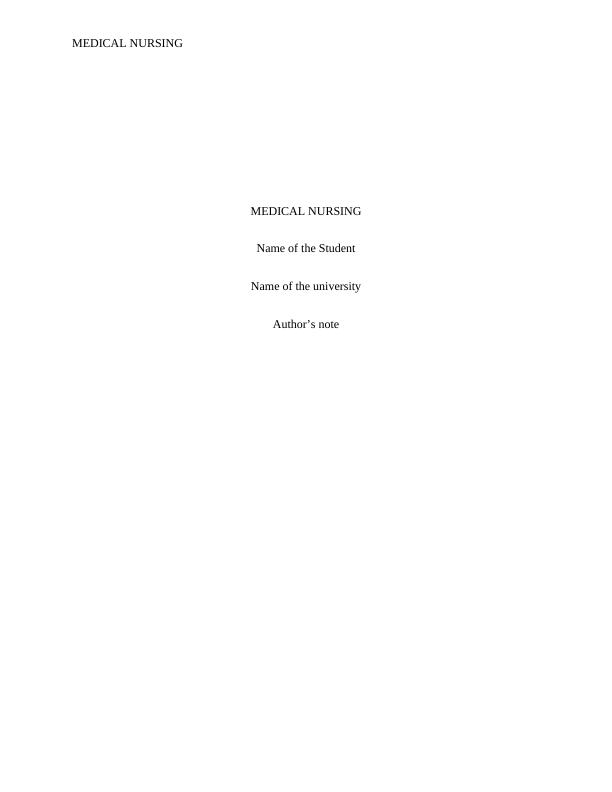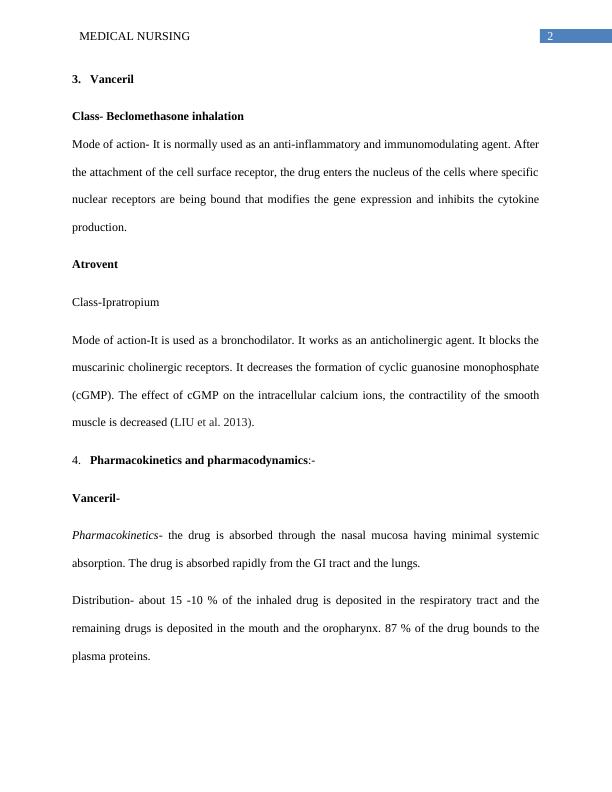Medical Nursing: Asthma and Pneumonia Case Studies
Added on 2023-06-09
15 Pages3455 Words94 Views
MEDICAL NURSING
MEDICAL NURSING
Name of the Student
Name of the university
Author’s note
MEDICAL NURSING
Name of the Student
Name of the university
Author’s note

1MEDICAL NURSING
ASSIGNMENT 1
CASE STUDY #7: ASTHMA
1. It is a chronic disorder of the airways, characterized by bronchoconstriction, airway edema
and airway hyper-responsiveness and airway remodeling. During the acute exacerbation of
asthma, the bronchial smooth muscles contract due to its exposure to a varieties of allergens
or irritants. Inspissated mucus plugs can be formed including structural changes such as
hyperplasia and hypertrophy in the airway of the smooth muscles (Hackett 2012). Furthermore
sub epithelial fibrosis, thickening of the basement membrane can lead to narrowing of the
airway causing respiratory distress. The mechanism involving the airway hyper-
responsiveness includes the neuro-regulation and airway inflammation (Doeing and Solway,
2013).
2. Inflammation plays the central role in the clinical progression of asthma. The inflammation
of the airway involves the interaction of several types of inflammatory cells like the
lymphocytes, mast cells, Eosinophil, dendritic cells, neutrophils and the epithelial cells.
There are several inflammatory mediators like cytokines, Chemokines, Cysteinyl-
leukotrienes, Nitric oxide (NO). The inhaled allergen stimulates the T helper type 2 (Th2)
cell proliferation, leading to the release of the Th2 cytokines, interleukin (IL)-4, IL-5 and IL-
13 by the activation of the mast cells, eosinophil and the neutrophils (Kudo et al. 2013).IgE
is the antibody that is accountable for the hypersensitivity reactions. The antibody attaches to
the surface of the cell via high affinity receptors that release the chemical inflammatory
mediators. The allergens can be taken up by the dendritic cells that process the antigenic
molecules and present them to the naïve T –cells. Finally the allergen specific Th2 cells are
activated.
ASSIGNMENT 1
CASE STUDY #7: ASTHMA
1. It is a chronic disorder of the airways, characterized by bronchoconstriction, airway edema
and airway hyper-responsiveness and airway remodeling. During the acute exacerbation of
asthma, the bronchial smooth muscles contract due to its exposure to a varieties of allergens
or irritants. Inspissated mucus plugs can be formed including structural changes such as
hyperplasia and hypertrophy in the airway of the smooth muscles (Hackett 2012). Furthermore
sub epithelial fibrosis, thickening of the basement membrane can lead to narrowing of the
airway causing respiratory distress. The mechanism involving the airway hyper-
responsiveness includes the neuro-regulation and airway inflammation (Doeing and Solway,
2013).
2. Inflammation plays the central role in the clinical progression of asthma. The inflammation
of the airway involves the interaction of several types of inflammatory cells like the
lymphocytes, mast cells, Eosinophil, dendritic cells, neutrophils and the epithelial cells.
There are several inflammatory mediators like cytokines, Chemokines, Cysteinyl-
leukotrienes, Nitric oxide (NO). The inhaled allergen stimulates the T helper type 2 (Th2)
cell proliferation, leading to the release of the Th2 cytokines, interleukin (IL)-4, IL-5 and IL-
13 by the activation of the mast cells, eosinophil and the neutrophils (Kudo et al. 2013).IgE
is the antibody that is accountable for the hypersensitivity reactions. The antibody attaches to
the surface of the cell via high affinity receptors that release the chemical inflammatory
mediators. The allergens can be taken up by the dendritic cells that process the antigenic
molecules and present them to the naïve T –cells. Finally the allergen specific Th2 cells are
activated.

2MEDICAL NURSING
3. Vanceril
Class- Beclomethasone inhalation
Mode of action- It is normally used as an anti-inflammatory and immunomodulating agent. After
the attachment of the cell surface receptor, the drug enters the nucleus of the cells where specific
nuclear receptors are being bound that modifies the gene expression and inhibits the cytokine
production.
Atrovent
Class-Ipratropium
Mode of action-It is used as a bronchodilator. It works as an anticholinergic agent. It blocks the
muscarinic cholinergic receptors. It decreases the formation of cyclic guanosine monophosphate
(cGMP). The effect of cGMP on the intracellular calcium ions, the contractility of the smooth
muscle is decreased (LIU et al. 2013).
4. Pharmacokinetics and pharmacodynamics:-
Vanceril-
Pharmacokinetics- the drug is absorbed through the nasal mucosa having minimal systemic
absorption. The drug is absorbed rapidly from the GI tract and the lungs.
Distribution- about 15 -10 % of the inhaled drug is deposited in the respiratory tract and the
remaining drugs is deposited in the mouth and the oropharynx. 87 % of the drug bounds to the
plasma proteins.
3. Vanceril
Class- Beclomethasone inhalation
Mode of action- It is normally used as an anti-inflammatory and immunomodulating agent. After
the attachment of the cell surface receptor, the drug enters the nucleus of the cells where specific
nuclear receptors are being bound that modifies the gene expression and inhibits the cytokine
production.
Atrovent
Class-Ipratropium
Mode of action-It is used as a bronchodilator. It works as an anticholinergic agent. It blocks the
muscarinic cholinergic receptors. It decreases the formation of cyclic guanosine monophosphate
(cGMP). The effect of cGMP on the intracellular calcium ions, the contractility of the smooth
muscle is decreased (LIU et al. 2013).
4. Pharmacokinetics and pharmacodynamics:-
Vanceril-
Pharmacokinetics- the drug is absorbed through the nasal mucosa having minimal systemic
absorption. The drug is absorbed rapidly from the GI tract and the lungs.
Distribution- about 15 -10 % of the inhaled drug is deposited in the respiratory tract and the
remaining drugs is deposited in the mouth and the oropharynx. 87 % of the drug bounds to the
plasma proteins.

3MEDICAL NURSING
Metabolism- Metabolism of the drug takes place inside the liver. The portion hat is inhaled in to
the respiratory tract is metabolized before its absorption in the systemic circulation.
Excretion- The metabolites are mainly excreted through the feces and some through the urine.
Pharmacodynamics
The drug stimulates the enzymes that are required to decrease the inflammatory action. It is used
to prevent bronchiole asthma, avoid the recurrent of the nasal polyps after the surgery.
Atrovent
Pharmacokinetics-
Absorption- It is not readily absorbed in to the systemic circulation either from the GI tract or the
lungs. The inhaled dose is normally swallowed.
Distribution- Not applicable
Metabolism- Hepatic metabolism and the half-life of elimination is 2 hours.
Excretion- The absorbed drug is normally excreted through bile and urine.
Pharmacodynamics-
Anticholinergic action- It antagonizes the action of acetyl choline, thus inhibiting the reflexes
that is vagally mediated. The Anticholinergic inhibits the augmentation of the intracellular cyclic
guanosine-monophosphate resulting in the interaction of the acetyl choline with the muscarinic
receptor present on the bronchia smooth muscles.
Metabolism- Metabolism of the drug takes place inside the liver. The portion hat is inhaled in to
the respiratory tract is metabolized before its absorption in the systemic circulation.
Excretion- The metabolites are mainly excreted through the feces and some through the urine.
Pharmacodynamics
The drug stimulates the enzymes that are required to decrease the inflammatory action. It is used
to prevent bronchiole asthma, avoid the recurrent of the nasal polyps after the surgery.
Atrovent
Pharmacokinetics-
Absorption- It is not readily absorbed in to the systemic circulation either from the GI tract or the
lungs. The inhaled dose is normally swallowed.
Distribution- Not applicable
Metabolism- Hepatic metabolism and the half-life of elimination is 2 hours.
Excretion- The absorbed drug is normally excreted through bile and urine.
Pharmacodynamics-
Anticholinergic action- It antagonizes the action of acetyl choline, thus inhibiting the reflexes
that is vagally mediated. The Anticholinergic inhibits the augmentation of the intracellular cyclic
guanosine-monophosphate resulting in the interaction of the acetyl choline with the muscarinic
receptor present on the bronchia smooth muscles.

End of preview
Want to access all the pages? Upload your documents or become a member.
Related Documents
Body Integrity Assignment PDFlg...
|5
|1450
|42
Asthma Pathophysiology | Nursing Assignmentlg...
|11
|3811
|19
Case Study on Asthmalg...
|9
|2383
|50
Asthma: Definition, Etiology, Pathogenesis, Signs and Symptoms, Interventions, and Nursing Implicationslg...
|10
|2137
|423
Acute Severe Asthma: Definition, Etiology, Pathogenesis, Signs and Symptomslg...
|9
|2162
|171
Pathophysiology Health carelg...
|13
|3498
|12
